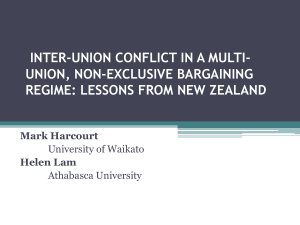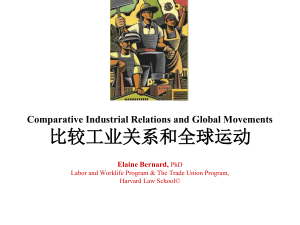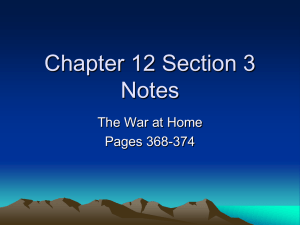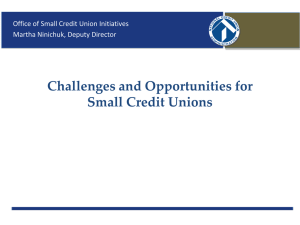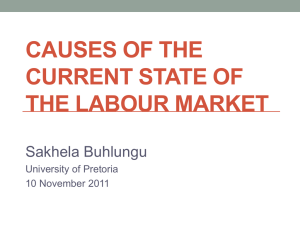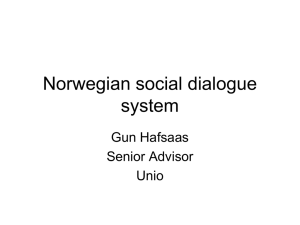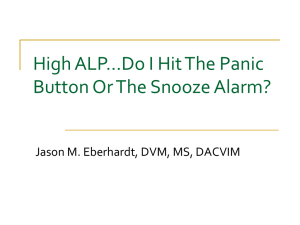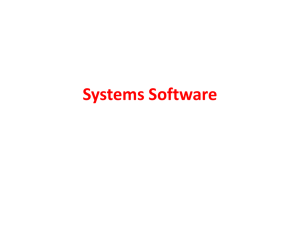Recommencing the Forward March of Labour
advertisement
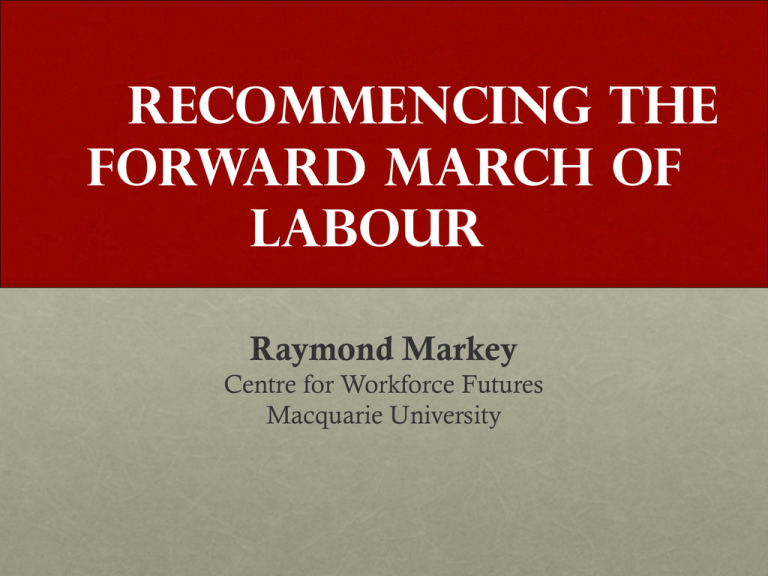
Recommencing the Forward March of Labour Raymond Markey Centre for Workforce Futures Macquarie University introduction Eric Hobsbawm 1978 lecture The Forward March of Labour Halted? • Analysed British Labour Party’s declining support base & drew on historical record to suggest ways forward • In same spirit I draw on ALP’s historical experience to address need for reform as support base has withered • Numerous reform proposals, some adopted, but most shallow • Particular focus on trade unions/party relationship & decline of classic social democratic nature • Weakening relationship with unions a strategic error, but relationship requires renovation • Historical record suggests way forward combining labour & citizen repertoires of contention that also maintain essential nature of party The problem • ALP holds office in only 2 States (SA & Vic) & 1 Territory (ACT) + probably Qld– all bar Vic minority governments • In preceding 5 years ALP lost government in Vic. (2010), NSW (2011), Qld (2012), NT (2012), Tas. (2014), & nationally (2013) • Large scale of defeats - NSW: ALP suffered 13% swing, gained 25% of primary vote & 20 seats of 93 – worst defeat of any govt in NSW history, worst swing against any Aust govt since WW2, & lowest % vote & seats since 1901 - Qld: 16% swing, 27% primary vote, 7 of 87 seats – lowest % votes since 1907 & seats since 1893 - Federal: 33% primary vote (Reps) lowest since 1931 but really 1903 • Special issues at play, & huge swings back to ALP in Qld 2015 & Vic 2014 after 1-term governments, but Long term decline • In 9 federal elections since 1987 when Hawke was returned as PM with 46% vote, ALP’s primary vote exceeded 40% only twice: - 1993 (45%) & 2007 (43%) which won it office - 40% insufficient in 1998, though 39% in 1990 won office for ALP • In preceding 30 elections 1906-87 ALP vote <40% only in 1931 & 1934 but exceptional because of Lang Labor split • ALP average primary vote for Reps: 39.3% 1990-2013, 46.5% 1910-87 • Several reasons, affecting Labour /SDPs parties internationally: - Voters & electorates more volatile Decline in class consciousness & collectivism Decline in traditional blue collar working class Decline in party membership Impacting all parties & civic organisations Growth in independents & minority governments as result unions/party relationship • Big impact of declining union membership: 56% 1975, to 17% 2014, private sector 12% • Unions founded ALP & maintain strong institutional links: • integration based on individual union affiliation- also typifies other LPs – UK, NZ • gives unions representation in internal structures, forums processes; influence in choice of parliamentary candidates • Unions rely on ‘quiet’ internal lobbying • Party derives financial & personnel resources & influence on workers • Convergence of elites & ideology, union leaders become MPs • Part of social democratic (SD) type: mass parties & collectivist ideology • Contrast pressure group (PG) type of non structured relationship: US unions & Democrats – relies more on external lobbying, political campaigning & community alliances Evolving unions/party relationship • Unions’ political capital & reach reduced by membership decline • More easily cast as 1 interest group amongst many • Decoupling of unions/party relationship in SD types (Hyman & Gumbrell-McCormick 2010; Piazza 2001; Upchurch et al. 2009; McIlroy1998; Quinn 2010; Lavelle 2010; Griffin et al. 2004) • Adoption of neoliberal policy settings & contingent strategic electoral choices by SDPs: • Deregulation of economy & labour market: competition & flexibility • Decline in collectivism in favour of individualist ideology • Transition from mass bureaucratic to autonomous electoral professional parties • Emergence of ‘catch-all’ political strategies to appeal to wider range of social groups (Howell 2000, Manning 1992, Smith 2009, Katz & Mair 1995) Evolving unions/party relationship 2 • Decline in % ALP MPs with union official background: - 79% in 1901 to 44% in 1962 - stabilised at 45% in 2013 but higher in Senate (55%) than Reps (40%) - Deceptive because few of these came through ranks of unions • Party power & resources shift to MPs & parliamentary leadership - focus groups, polls, electronic media • Small gene pool of MPs: former staffers, union officials (with limited work experience), party functionaries • Existence of highly organised factions contribute to centralisation & reduction in role for rank & file members – but factions are clans or tribes for distribution of benefits & power, not ideological • Increasingly professional isolated political elite – decline in membership unsurprising Reform proposals • Various ALP reviews since 1979, most recent 2010 • Centralisation of electoral campaigns, • Improved communication re policy • Partnerships with NGOs & advocacy groups with compatible aims • US style primaries, & some trialled • Election of parliamentary leader by caucus & membership • Easier online membership • Greater membership voice in pre-selection & conference • Mixed usefulness Reforming unions relationship • Reform commonly framed as curtailing unions’ importance & influence • Union representation at conferences reduced to 50% in 2003, & calls now for further reductions, recently Senator Faulkner to 20% • 2002 review referred to ‘partnership’ with unions • 2010 review refers less extensively & more vaguely to ‘links’ with unions, with equal emphasis on other ‘community organisations’ • Shorten re removing union membership prerequisite for ALP: ‘It used to be said that Labor was the political arm of the union movement. I’m saying today , as proud as I am of unions & what they’ve done, that the Labor party is the political arm of no one but the Australian people’. • Broad appeal to ‘the people’ traditional & electorally necessary • But a huge strategic error to further distance ALP from unions: still largest representative civil institution in Australia rivalled only by numbers who at least occasionally attend religious services – resources & mobilisation potential real problem with the unions/ALP relationship • Unions with influence in the ALP are unrepresentative of unions • 11 unions account for all ALP MPs with union official background, 9 of which are affiliated • Almost half of 39 ALP MPS with union background provided by 3 unions: SDA (8), TWU (5), ASU (5) • Change in union composition: • Decline in traditional blue-collar union base: mainly ALP affiliates • Growth in white-collar, professional & public service unionism: mainly unaffiliated • Unionism concentrated in health, education, retail & govt administration • Public sector unionism accounts for 41% of all members, density 42% compared to 12% in private sector • Problem is influence of small number of unrepresentative union bosses Broadening repertoires of contention (Gentile 2011, 2014; Gentile & Tarrow 2009) • Labour repertoires: associated with SD type of unions/party relationship • Political unionism, collective bargaining & industrial action, based on statutes unions influence through party relationship when in govt. • Corporatist (Scandinavia, Germany) or Anglo (Oz, UK, NZ) regimes • Citizen repertoires: US style PG type relationship • Focus on citizen rights because more embedded & protected than labour rights that have always been more contested in US • more widespread as unions decline • Labour’s legal & political exchange rights constrained & labour decategorised as member of the polity especially in neoliberal regimes • Labour draws on citizen rights & collective action characteristic of social movements – demonstrations & community action rather than pickets • Strategies for union revitalisation often associated with citizen repertoire • US unions’ organising model associated with social movement or community unionism, developing links with broader social & community groups – chrches, student groups, environmentalists, NGOs. Australian union citizen repertoires • ACTU adopted US-style Organising Works program 1994, • recruitment & campaigning over key issues, • creative campaign tactics, including demonstrations, media events, development of strong networks of worker & community activists • associated with social movement/community unionism • Unions relied on community coalitions in 1998 maritime dispute • ACTU-led Your Rights at Work campaign against WorkChoices 2005-7: • Unions’ independent mobilisation directed at 2007 elections • ‘union power’ (labour rights) removed from contention: WorkChoices framed as threat to individual rights & working conditions • Information & media campaign, focus groups identified issues for working families, TV ads based on individuals • Unionists mobilised in workplaces, phone & house calls, local events, online • Highly successful in shifting IR debate & election results (1929 example too) • YRaW represents a shift to citizen repertoire • Australian unions now have hybrid labour & citizen strategic repertoires • Need strategy to build on this for political mobilisation 4 Lessons from history 1. Broad appeal: alliances with other progressive organisations in 1890s & selection of diverse range of candidates 1890s-1980s 2. Established party platform: development & communication of ‘Labor culture’ in 1910 (Dyrenfurth 2012); Whitlam’s platform & ‘mandate’ 3. Key role in 1890s of peak union councils in political mobilisation in colonies: in 2 most early successful parties in NSW & Qld., NSW TLC & ALF represented most unions, though union density low (20% NSW) 4. Local basis of organisation: unions & branches more localised & autonomous in 1890s & early 1900s 1 & 2 partially addressed by existing proposals, but not 3 & 4 Ways forward 1. Enhance relationship with ACTU, representing most unions • • • • • • Can play same political mobilisation role as 1890s peak bodies Draw on Your Rights at Work Campaign 2005-7 ALAC (Australian Labor Advisory Council) previously brought ALP & ACTU leaders together for policy discussion dormant for years – could be revived & extended Norwegian Labour Party & LO meet weekly in consultative committee Swedish, Norwegian & (until 1995) Danish parties have peak body representation on SDP executives Political mobilisation around platform beforehand rather than reacting to policies of Lib/Nat governments Ways forward 2 2. Replace union affiliation at central or State level with affiliation of union local branches or workplace groups to local party branches - Following Swedish practice • Only where local union groups sufficiently engaged with ALP • Could be based on substantial work sites, clusters of work sites, or residential areas with substantial numbers in particular unions • Might require realignment of branch boundaries, or new branches • Advantages: Bolster membership at branch level • Reduce influence of factions at party conferences by breaking central control of union bloc voting A renewed SD type relationship providing opportunity for greater rank & file participation at grass roots plus coordination with ACTU representing all unionists. Reinvigorate ALP position as mass party of workers instead of party of disconnected ‘union bosses’. Conclusion • Combination of labour & citizen repertoires to mobilise workers politically

